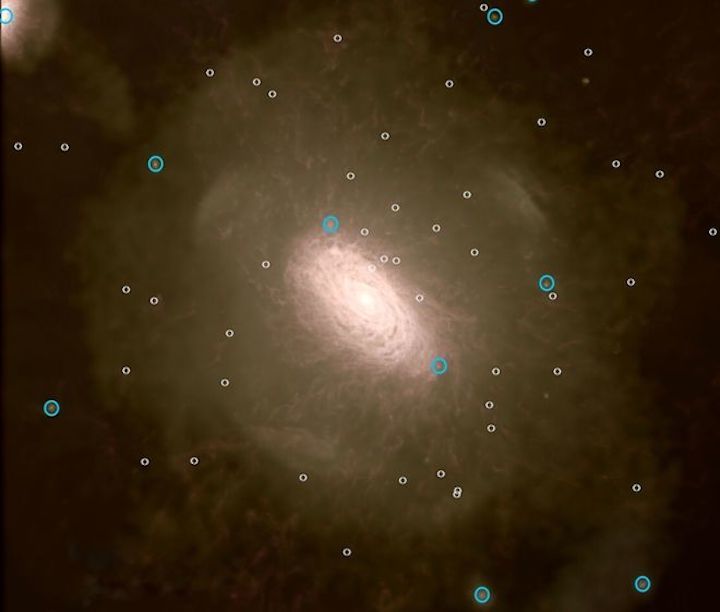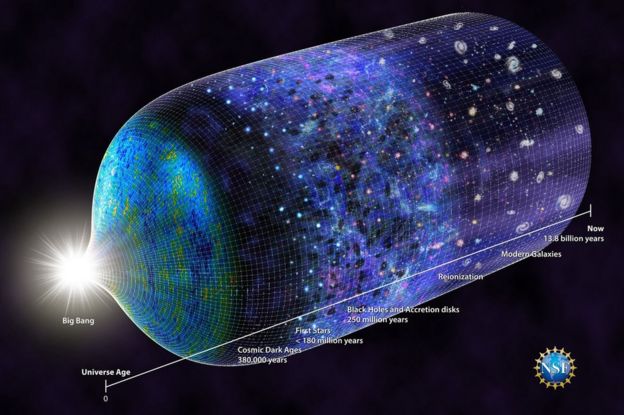17.08.2018

A computer simulation of galaxy formation: White circles show some of the most ancient building blocks
-
Some of the earliest galaxies to form in the Universe are sitting on our cosmic doorstep, according to a study.
These faint objects close to the Milky Way could be more than 13 billion years old, researchers from the universities of Durham and Harvard explain.
They formed upwards of a hundred million years after the Big Bang and contained some of the first stars to light up the cosmos.
The findings are published in the Astrophysical Journal.
Our own galaxy, the Milky Way, is one of billions out there in the Universe. These sprawling cosmic neighbourhoods filled with stars and planets formed when many smaller building blocks - such as these galaxies - collided and merged.
The discovery opens a window into what the Universe was like more than 13 billion years ago.
Prof Carlos Frenk, from Durham University, UK, said: "Finding some of the very first galaxies that formed in our Universe orbiting in the Milky Way's own backyard is the astronomical equivalent of finding the remains of the first humans that inhabited the Earth. It is hugely exciting."

Lead author Dr Sownak Bose, from the Harvard-Smithsonian Center for Astrophysics in Cambridge, US, told BBC News: "For some of these tiny satellites, maybe 50% or even 90% of their mass was assembled at a time when the Universe was less than one billion years old."
The astronomers looked at something called the "luminosity function" of small satellite galaxies that orbit the Milky Way and its neighbour Andromeda.
Luminosity describes the total amount of energy radiated each second by an astronomical source. The "function" gives the abundance of galaxies for a given luminosity.
When the researchers plotted the galaxies' luminosity functions on a graph, they separated into two distinct populations.
Prof Frenk, Dr Bose and co-author Dr Alis Deason from Durham found an existing model of galaxy formation explained the data perfectly, allowing them to infer the formation times of the satellite galaxies.
The first population of galaxies appears to have been formed during the "cosmic dark ages", a period of cooling which began some 380,000 years after the Big Bang and lasted for 100 million years.
The second population, consisting of slightly brighter galaxies, seems to have formed hundreds of millions of years after the first.
 Image copyrightNSF
Image copyrightNSF
The onset of the cosmic dark ages is tied to the formation of the very first atoms in the Universe. These were hydrogen atoms, the simplest element in the periodic table.
As the hydrogen gathered into clouds, it began to cool. These hydrogen clouds then settled within small clumps of the enigmatic stuff known as dark matter, which emerged in the Big Bang. As the name suggests, dark matter neither reflects nor emits visible light, yet it makes up 85% of all matter in the Universe.
The reason the two populations of galaxies are so distinct is that the first galaxies emitted intense ultraviolet radiation while the Universe was still locked in the dark ages. This destroyed the remaining hydrogen atoms by ionising them (knocking out their electrons), making it difficult for this gas to cool and form new stars.
Consequently, the process of galaxy formation ground to a halt and no new galaxies were able to form for the next billion years or so. This next cosmological phase goes by the name "reionisation".
The hiatus came to an end when the clumps of dark matter into which the gas had settled became so massive that even that ionised gas was able to cool down. This allowed galaxy formation to resume, leading to spectacular bright galaxies; one of which is our Milky Way.
 Image copyrightSCIENCE PHOTO LIBRARY
Image copyrightSCIENCE PHOTO LIBRARY
The galaxy evolution model favoured by the astronomers predicts that there should be a "kink" in the transition between the fainter galaxies and the brighter galaxies - as determined by their luminosity functions.
This should correspond to the billion-year stoppage in galaxy formation caused by the ionisation of gas towards the end of the dark ages. It's exactly what the researchers saw in their data.
Further study should help flesh out our understanding.
"If you go and examine these primitive galaxies, you should find bizarre things about them. Being the first ones, they should have properties that are unique to them," said Prof Frenk.
Dr Bose explained: "One could think that, maybe some of these pre-reionisation galaxies are more compact than their counterparts that formed afterwards. They were formed at a time when the Universe was much denser, because the Universe was smaller."
While hydrogen and helium were made in the Big Bang, the other, the heavier chemical elements we're made of were produced inside stars. When stars go supernova, they pollute the galactic environment with their chemical constituents.
However, the abundance of different elements in the Universe has changed with time. So it's possible that the way they're distributed in the earliest galaxies is different to how they're dispersed in ones that formed after reionisation.
Although these ancient galaxies are found on our cosmic doorstep, that's because being relatively close makes these faint objects easier to find.
However, these cosmic relics should be found throughout in the Universe and may, in fact, far outnumber bright galaxies like the Milky Way.
Quelle: BBC
